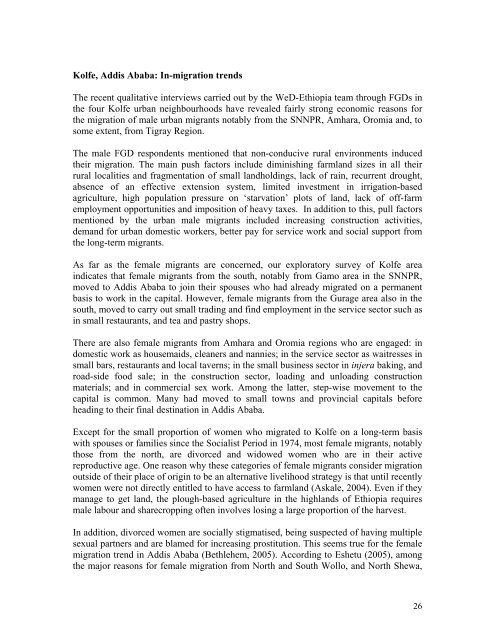Migration and Rural-Urban Linkages in Ethiopia
Migration and Rural-Urban Linkages in Ethiopia - Ethiopian Review
Migration and Rural-Urban Linkages in Ethiopia - Ethiopian Review
You also want an ePaper? Increase the reach of your titles
YUMPU automatically turns print PDFs into web optimized ePapers that Google loves.
Kolfe, Addis Ababa: In-migration trendsThe recent qualitative <strong>in</strong>terviews carried out by the WeD-<strong>Ethiopia</strong> team through FGDs <strong>in</strong>the four Kolfe urban neighbourhoods have revealed fairly strong economic reasons forthe migration of male urban migrants notably from the SNNPR, Amhara, Oromia <strong>and</strong>, tosome extent, from Tigray Region.The male FGD respondents mentioned that non-conducive rural environments <strong>in</strong>ducedtheir migration. The ma<strong>in</strong> push factors <strong>in</strong>clude dim<strong>in</strong>ish<strong>in</strong>g farml<strong>and</strong> sizes <strong>in</strong> all theirrural localities <strong>and</strong> fragmentation of small l<strong>and</strong>hold<strong>in</strong>gs, lack of ra<strong>in</strong>, recurrent drought,absence of an effective extension system, limited <strong>in</strong>vestment <strong>in</strong> irrigation-basedagriculture, high population pressure on ‘starvation’ plots of l<strong>and</strong>, lack of off-farmemployment opportunities <strong>and</strong> imposition of heavy taxes. In addition to this, pull factorsmentioned by the urban male migrants <strong>in</strong>cluded <strong>in</strong>creas<strong>in</strong>g construction activities,dem<strong>and</strong> for urban domestic workers, better pay for service work <strong>and</strong> social support fromthe long-term migrants.As far as the female migrants are concerned, our exploratory survey of Kolfe area<strong>in</strong>dicates that female migrants from the south, notably from Gamo area <strong>in</strong> the SNNPR,moved to Addis Ababa to jo<strong>in</strong> their spouses who had already migrated on a permanentbasis to work <strong>in</strong> the capital. However, female migrants from the Gurage area also <strong>in</strong> thesouth, moved to carry out small trad<strong>in</strong>g <strong>and</strong> f<strong>in</strong>d employment <strong>in</strong> the service sector such as<strong>in</strong> small restaurants, <strong>and</strong> tea <strong>and</strong> pastry shops.There are also female migrants from Amhara <strong>and</strong> Oromia regions who are engaged: <strong>in</strong>domestic work as housemaids, cleaners <strong>and</strong> nannies; <strong>in</strong> the service sector as waitresses <strong>in</strong>small bars, restaurants <strong>and</strong> local taverns; <strong>in</strong> the small bus<strong>in</strong>ess sector <strong>in</strong> <strong>in</strong>jera bak<strong>in</strong>g, <strong>and</strong>road-side food sale; <strong>in</strong> the construction sector, load<strong>in</strong>g <strong>and</strong> unload<strong>in</strong>g constructionmaterials; <strong>and</strong> <strong>in</strong> commercial sex work. Among the latter, step-wise movement to thecapital is common. Many had moved to small towns <strong>and</strong> prov<strong>in</strong>cial capitals beforehead<strong>in</strong>g to their f<strong>in</strong>al dest<strong>in</strong>ation <strong>in</strong> Addis Ababa.Except for the small proportion of women who migrated to Kolfe on a long-term basiswith spouses or families s<strong>in</strong>ce the Socialist Period <strong>in</strong> 1974, most female migrants, notablythose from the north, are divorced <strong>and</strong> widowed women who are <strong>in</strong> their activereproductive age. One reason why these categories of female migrants consider migrationoutside of their place of orig<strong>in</strong> to be an alternative livelihood strategy is that until recentlywomen were not directly entitled to have access to farml<strong>and</strong> (Askale, 2004). Even if theymanage to get l<strong>and</strong>, the plough-based agriculture <strong>in</strong> the highl<strong>and</strong>s of <strong>Ethiopia</strong> requiresmale labour <strong>and</strong> sharecropp<strong>in</strong>g often <strong>in</strong>volves los<strong>in</strong>g a large proportion of the harvest.In addition, divorced women are socially stigmatised, be<strong>in</strong>g suspected of hav<strong>in</strong>g multiplesexual partners <strong>and</strong> are blamed for <strong>in</strong>creas<strong>in</strong>g prostitution. This seems true for the femalemigration trend <strong>in</strong> Addis Ababa (Bethlehem, 2005). Accord<strong>in</strong>g to Eshetu (2005), amongthe major reasons for female migration from North <strong>and</strong> South Wollo, <strong>and</strong> North Shewa,26




![to read the full report [pdf, Amharic] - Ethiopian Review](https://img.yumpu.com/52737829/1/190x245/to-read-the-full-report-pdf-amharic-ethiopian-review.jpg?quality=85)











